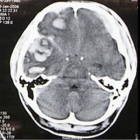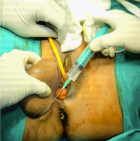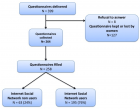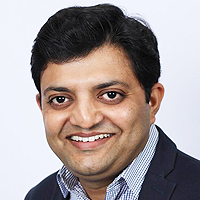Figure 2
Exploring Environmental Neurotoxicity Assessment Using Human Stem Cell-Derived Models
Narimane Kebieche*, Farzana Liakath Ali, Seungae Yim, Mohamed Ali, Claude Lambert and Rachid Soulimani
Published: 15 November, 2024 | Volume 8 - Issue 1 | Pages: 054-068

Figure 2:
Illustrates the use of 3D iPSC-based organoids and their applications in neurotoxicity research. (A.a) Cerebral organoids are derived from iPSC-generated embroids cultivated within spinning bioreactors during suspension culture. (A.b) Additionally, cerebral organoids are developed from iPSC-derived neural progenitor cells (NPCs) cultured within scaffold-assisted structures incorporating biomaterials like Matrigel. (A.c) Assembloids, formed by assembling cerebral organoids such as dorsal forebrain spheroids and ventral forebrain spheroids, enable the recreation of the dorsal-ventral forebrain axis, facilitating the investigation of interneuron migration. (A.d) The blood-brain-barrier model is generated from human iPSCs, producing astrocytes, pericytes, and endothelial cells that self-aggregate into neurospheres with defined structural layers. (A.e) Endogenous vascularization of cerebral organoids is induced by hETV2 infection to create vascular-like networks, enhancing organoid maturation. (A.f) A microfluidic organ-on-a-chip system models neural-vascular interactions with iPSC-derived neural progenitors and brain endothelial cells seeded in separate channels. (A.g) Multi-organ-on-a-chip systems enable simultaneous culture of hiPSC-derived cells (e.g., neural progenitors, hepatocytes, enterocytes) to replicate inter-organ interactions such as brain-liver-gut communication. (B.a) High-throughput screening of neurotoxic compounds is conducted using iPSC-derived models. (B.b) Mechanisms of toxicity, such as CPF-induced mitochondrial dysfunction and neurogenesis disruption, are elucidated. (B.c) Personalized medicine utilizes patient-specific iPSCs to create disease models for drug development, advancing candidates to clinical trials. (B.d) Inter-organ communication is modeled using multi-organ chips to assess the systemic effects of neurotoxic compounds through endpoints such as cell proliferation, differentiation markers, and metabolic activity. (Figure created with BioRender.com)
Read Full Article HTML DOI: 10.29328/journal.jsctt.1001044 Cite this Article Read Full Article PDF
More Images
Similar Articles
-
Exploring Environmental Neurotoxicity Assessment Using Human Stem Cell-Derived ModelsNarimane Kebieche*,Farzana Liakath Ali,Seungae Yim,Mohamed Ali,Claude Lambert,Rachid Soulimani. Exploring Environmental Neurotoxicity Assessment Using Human Stem Cell-Derived Models. . 2024 doi: 10.29328/journal.jsctt.1001044; 8: 054-068
Recently Viewed
-
Impact of Latex Sensitization on Asthma and Rhinitis Progression: A Study at Abidjan-Cocody University Hospital - Côte d’Ivoire (Progression of Asthma and Rhinitis related to Latex Sensitization)Dasse Sery Romuald*, KL Siransy, N Koffi, RO Yeboah, EK Nguessan, HA Adou, VP Goran-Kouacou, AU Assi, JY Seri, S Moussa, D Oura, CL Memel, H Koya, E Atoukoula. Impact of Latex Sensitization on Asthma and Rhinitis Progression: A Study at Abidjan-Cocody University Hospital - Côte d’Ivoire (Progression of Asthma and Rhinitis related to Latex Sensitization). Arch Asthma Allergy Immunol. 2024: doi: 10.29328/journal.aaai.1001035; 8: 007-012
-
Olfactory Dysfunction in Sports Players following Moderate and Severe Head Injury: A Possible Cut-off from Normality to PathologyGesualdo M Zucco*,Andrea Carletti,Richard J Stevenson. Olfactory Dysfunction in Sports Players following Moderate and Severe Head Injury: A Possible Cut-off from Normality to Pathology. J Sports Med Ther. 2016: doi: 10.29328/journal.jsmt.1001001; 1: 001-005
-
Emerging Trends in Sports Cardiology: The Role of Micronutrients in Cardiovascular Health and PerformanceBiswajit Sharma, Kishore Mukhopadhyay*. Emerging Trends in Sports Cardiology: The Role of Micronutrients in Cardiovascular Health and Performance. J Sports Med Ther. 2024: doi: 10.29328/journal.jsmt.1001086; 9: 073-082
-
Transforming Cancer Care through Physical Exercise: A Path to Holistic HealingJorma Sormunen*. Transforming Cancer Care through Physical Exercise: A Path to Holistic Healing. J Sports Med Ther. 2024: doi: 10.29328/journal.jsmt.1001088; 9: 089-090
-
Hypochlorous acid has emerged as a potential alternative to conventional antibiotics due to its broad-spectrum antimicrobial activityMaher M Akl*. Hypochlorous acid has emerged as a potential alternative to conventional antibiotics due to its broad-spectrum antimicrobial activity. Int J Clin Microbiol Biochem Technol. 2023: doi: 10.29328/journal.ijcmbt.1001026; 6: 001-004
Most Viewed
-
Evaluation of Biostimulants Based on Recovered Protein Hydrolysates from Animal By-products as Plant Growth EnhancersH Pérez-Aguilar*, M Lacruz-Asaro, F Arán-Ais. Evaluation of Biostimulants Based on Recovered Protein Hydrolysates from Animal By-products as Plant Growth Enhancers. J Plant Sci Phytopathol. 2023 doi: 10.29328/journal.jpsp.1001104; 7: 042-047
-
Sinonasal Myxoma Extending into the Orbit in a 4-Year Old: A Case PresentationJulian A Purrinos*, Ramzi Younis. Sinonasal Myxoma Extending into the Orbit in a 4-Year Old: A Case Presentation. Arch Case Rep. 2024 doi: 10.29328/journal.acr.1001099; 8: 075-077
-
Feasibility study of magnetic sensing for detecting single-neuron action potentialsDenis Tonini,Kai Wu,Renata Saha,Jian-Ping Wang*. Feasibility study of magnetic sensing for detecting single-neuron action potentials. Ann Biomed Sci Eng. 2022 doi: 10.29328/journal.abse.1001018; 6: 019-029
-
Pediatric Dysgerminoma: Unveiling a Rare Ovarian TumorFaten Limaiem*, Khalil Saffar, Ahmed Halouani. Pediatric Dysgerminoma: Unveiling a Rare Ovarian Tumor. Arch Case Rep. 2024 doi: 10.29328/journal.acr.1001087; 8: 010-013
-
Physical activity can change the physiological and psychological circumstances during COVID-19 pandemic: A narrative reviewKhashayar Maroufi*. Physical activity can change the physiological and psychological circumstances during COVID-19 pandemic: A narrative review. J Sports Med Ther. 2021 doi: 10.29328/journal.jsmt.1001051; 6: 001-007

HSPI: We're glad you're here. Please click "create a new Query" if you are a new visitor to our website and need further information from us.
If you are already a member of our network and need to keep track of any developments regarding a question you have already submitted, click "take me to my Query."




























































































































































